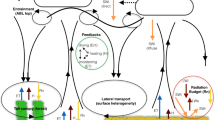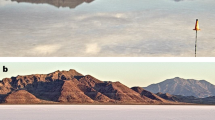Summary
The influence of elevational changes on plant transpiration was evaluated using leaf energy balance equations and well-known elevational changes in the physical parameters that influence water vapor diffusion. Simulated transpirational fluxes for large leaves with low and high stomatal resistances to water vapor diffusion were compared to small leaves with identical stomatal resistances at elevations ranging from sea level to 4 km. The specific influence of various air temperature lapse rates was also tested. Validation of the simulated results was accomplished by comparing actual field measurements taken at a low elevation (300 m) desert site with similar measurements for a high elevation (2,560 m) mountain research site. Close agreement was observed between predicted and measured values of transpiration for the environmental and leaf parameters tested.
Substantial increases in solar irradiation and the diffusion coefficient for water vapor in air (D wv) occurred with increasing elevation, while air and leaf temperatures, the water vapor concentration difference between the leaf and air, longwave irradiation, and the thermal conductivity coefficient for heat in air decreased with increasing elevation. These changes resulted in temperatures for sunlit leaves that were further above air temperature at higher elevations, especially for large leaves. For large leaves with low stomatal resistances, transpirational fluxes for low-elevation desert plants were close to those predicted for high-elevation plants even though the sunlit leaf temperatures of these mountain plants were over 10°C cooler. Simulating conditions with a low air temperature lapse rate (0.003° C m-1 and 0.004° C m-1) resulted in predicted transpirational fluxes that were greater than those calculated for the desert site. Transpiration for smaller leaves decreased with elevation for all lapse rates tested (0.003° C m-1 to 0.010° C m-1). However, transpirational fluxes at higher elevations were considerably greater than expected for all leaves, especially larger leaves, due to the strong influence of increased solar heating and a greater D wv. These results are discussed in terms of similarities in leaf structure and plant habit observed among low-elevation desert plants and high-elevation alpine and subalpine plants.
Similar content being viewed by others
References
Becker, C.F., Boyd, J.S.: Availability of solar energy. Agr. Engin. 42, 302–305 (1961)
Billings, W.D., Mooney, H.A.: The ecology of arctic and alpine plants. Biol. Rev. 43, 481–529 (1968)
Billings, W.D., Clebsch, E.E.C., Mooney, H.A.: Effect of low concentrations of carbon dioxide on photosynthesis rates of two races of Oxyria. Science 133, 1834–1835 (1961)
Boynton, W.P., Brattain, W.H.: Interdiffusion of gases and vapors. Intern. Critical Tables 5, 62–64 (1929)
Campbell, G.S.: An introduction to environmental biophysics. Berlin-Heidelberg-New York: Springer 1977
Crafts, A.S., Currier, H.B., Stocking, C.R.: Water in the physiology of plants. New York: Ronald Press 1949
Gale, J.: Availability of carbon dioxide for photosynthesis at high altitudes: theoretical considerations. Ecology 53, 494–497 (1972)
Gale, J.: Experimental evidence for the effect of barometric pressure on photosynthesis and transpiration. In: Plant response to climatic factors, pp. 289–294, UNESCO, Proc. Uppsala Symp., Ecology and Conservation 5, 1973
Gates, D.M.: Transpiration and leaf temperature. Ann. Rev. Plant Physiol. 19, 211–238 (1968)
Goss, J.R., Brooks, F.A.: Constants for empirical expressions for downcoming atmospheric radiation under cloudless sky. J Meteor. 13, 482–488 (1956)
Hadley, F.B., Bliss, L.C.: Energy relationships of alpine plants on Mt. Washington, New Hampshire. Ecol. Monog. 34, 331–357 (1964)
Katznelson, Y.: Regional climatology of Palestine (Hebrew). Encycl. Agric. 1, 27–64 (1956)
Marr, J.W.: Atmospheric factors of Front Range Colorado regional ecosystems. Bull. Ecol. Soc. Am. 47, 198–199 (1966)
Michaelis, P.: Ökologische Studien an der alpinen Baumgrenze. IV. Zur Kenntnis des winterlichen Wasserhaushaltes. Jahrb. Wiss. Botan. 80, 169–247 (1934)
Monteith, J.L.P.: Principles of environmental physics. New York: American Elsevier 1973
Montgomery, R.B.: Viscosity and thermal conductivity of air and diffusivity of water vapor in air. J. Meteor. 4, 193–196 (1948)
Mooney, H.A., Hillier, R.D., Billings, W.D.: Transpirational rates of alpine plants in the Sierra Nevada of California. Amer. Mid. Nat. 74, 374–386 (1965)
Mooney, H.A., Strain, B.R., West, M.: Photosynthetic efficiency at reduced carbon dioxide tensions. Ecology 47, 490–491 (1966)
Munn, R.E.: Descriptive micrometeorology, New York-London: Academic Press 1966
Nobel, P.S.: Biophysical plant physiology. San Francisco: Freeman 1974
Prutzer, E.: Die Verdunstungsverhältnisse einiger subalpiner Standorte. Mitt. Forstl. Bundes-Vers.-Anst. Mariabrunn (Wien) 59, 231–256 (1961)
Rathschüler, E.: Über die Änderung des Tagesganges der Luftfeuchtigkeit mit der Höhe im Gebirge. Arch. Meteorol. Geophys. Bioklimatol. Ser. B 1, 17–31 (1948)
Rechard, P.A., Smith, V.E.: Physical and hydrometeorological characteristics of the Snowy Range Water Resources Observatory. Water Resources Series No. 31, Research Institute, Univ. Wyoming, Laramie 1972
Saucier, W.J.: Principles of meteorological analysis. Chicago: Univ. Chicago Press 1955
Smith, W.K.: Temperatures of desert plants: another perspective on the adaptability of leaf size. Science 201, 614–616 (1978)
Smith, W.K., Nobel, P.S.: Temperature and water relationships for sun and shade leaves of a desert broadleaf, Hyptis emoryi. J. Exp. Bot. 28, 171–185 (1977a)
Smith, W.K., Nobel, P.S.: Influences of seasonal changes in leaf morphology on water-use efficiency for three desert broadleaf shrubs. Ecology 58, 1033–1043 (1977b)
Taylor, S.E.: Optimal leaf form. In: Perspectives of biophysical ecology (D.M. Gates, R.B. Schmerl, eds.), pp. 73–83. Berlin-Heidelberg-New York: Springer 1975
Ting, I.P.: Ecology. In: Deep canyon, a desert wilderness for science (I.P. Ting, B. Jennings, eds.), pp. 81–87. University of California, Riverside 1976
Tranquillini, W.: Water relations and alpine timberline. In: Water and plant life (O.L. Lange, L. Kappan, E.-D. Schulze, eds.), pp. 473–491. Berlin-Heidelberg-New York: Springer 1976
Tranquillini, W., Turner, H.: Untersuchungen über die Pflanzentemperaturen in der subalpinen Stufe mit besonderer Berücksichtigung der Nadeltemperaturen der Zirbe. Mitt. Forstl. Bundes-Vers.-Anst. Mariabrunn (Wien) 59, 127–151 (1961)
Vitkevich, V.I.: Agricultural meteorology. Jerusalem: Israel Program for Scientific Translations 1963
Walter, H.: Vegetation of the earth (Trans. by J. Wieser). London: English Universities Press 1973
Went, F.W.: Annual plants at high altitudes in the Sierra Nevada, California. Madroño 12, 109–114 (1953)
Wilson-Warren, J.: Notes on wind and its effects in arctic-alpine vegetation. J. Ecol. 47, 415–427 (1959)
Author information
Authors and Affiliations
Rights and permissions
About this article
Cite this article
Smith, W.K., Geller, G.N. Plant transpiration at high elevations: Theory, field measurements, and comparisons with desert plants. Oecologia 41, 109–122 (1979). https://doi.org/10.1007/BF00344841
Received:
Issue Date:
DOI: https://doi.org/10.1007/BF00344841




